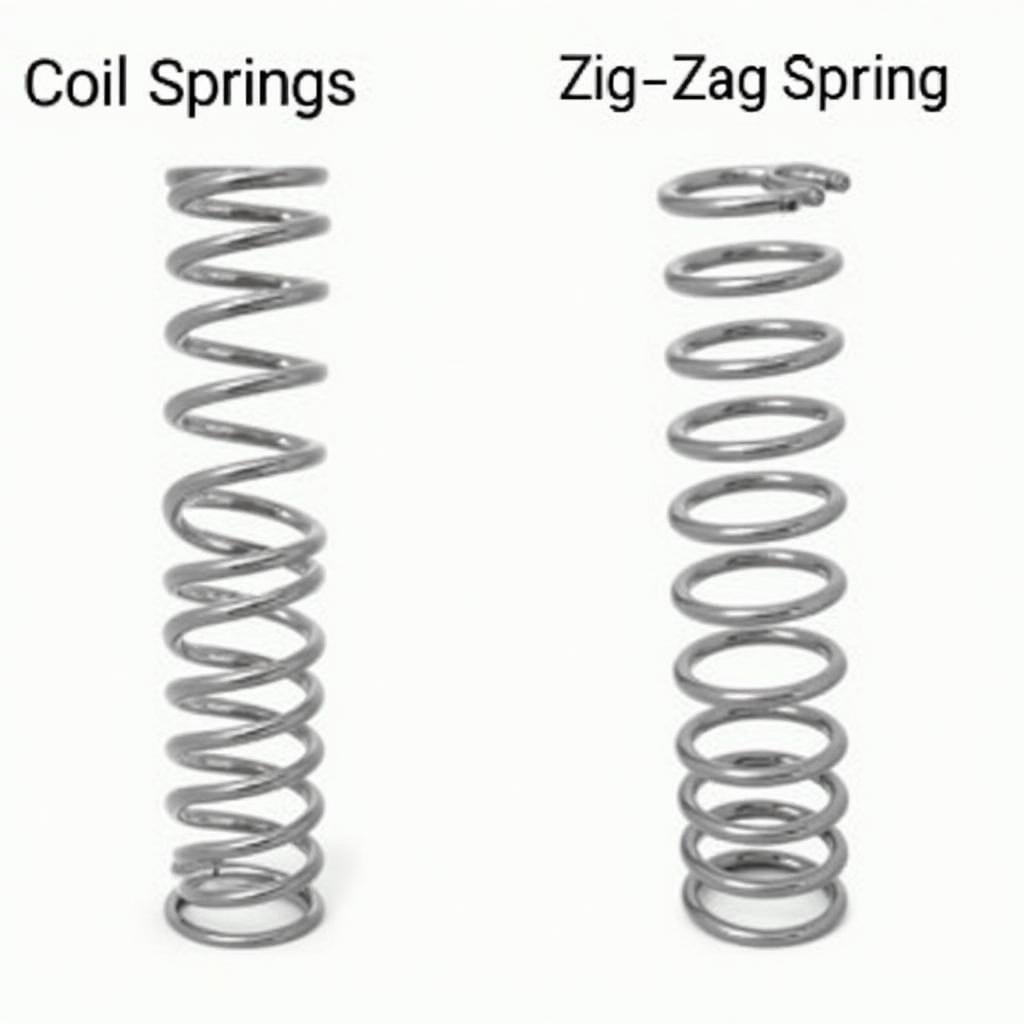A broken or sagging car seat can make driving uncomfortable and even lead to back pain. Often, the culprit behind this discomfort is damaged car seat springs. While it might seem daunting, learning how to repair car seat springs can save you a costly trip to the mechanic. This guide will provide you with a step-by-step approach to tackle this repair yourself.
Understanding Car Seat Springs
Before diving into the repair process, it’s essential to understand the different types of car seat springs and how they function. Most car seats utilize one of two main types: coil springs or zig-zag springs.
Coil Springs: These are the most common type, offering excellent support and durability. They resemble traditional bed springs and are attached to the seat frame, working individually to provide cushioning.
Zig-Zag Springs: These springs are shaped in a “Z” pattern and run across the seat’s width. They offer a firmer feel compared to coil springs and are generally found in older vehicles.
 Types of Car Seat Springs
Types of Car Seat Springs
Identifying the Problem
The first step to any repair is accurate diagnosis. To determine if your car seat springs need fixing, look for these telltale signs:
- Sagging: Noticeable dips or depressions in the seat, particularly where you usually sit.
- Squeaking or Noise: Unusual noises when you sit down or adjust your position.
- Uneven Support: Feeling the seat frame or a bar underneath the cushion.
- Visible Damage: If you can access the springs, look for broken, bent, or detached springs.
Gathering Your Tools and Materials
Once you’ve confirmed the issue, gather the necessary tools and materials:
- Screwdrivers: Flathead and Phillips head in various sizes to remove seat covers and access the springs.
- Pliers: For gripping, bending, and adjusting springs.
- Hog Ring Pliers: These are essential for removing and installing the hog rings that secure the springs.
- Replacement Springs: If your springs are broken, purchase replacements that match your car’s make, model, and year.
- Hog Rings: These small metal rings hold the springs in place.
- Upholstery Fabric Repair Kit: If you need to repair minor tears or rips in the upholstery while accessing the springs.
How to Repair Car Seat Springs: Step-by-Step
Here’s a general guide on how to repair car seat springs. Remember that the exact process may vary depending on your car model.
-
Safety First: Disconnect the negative terminal of your car battery to prevent any electrical mishaps.
-
Remove the Seat: Access the mounting bolts, usually located at the base of the seat, and carefully remove the seat from the vehicle.
-
Detach the Upholstery: Carefully remove the upholstery from the seat frame. This typically involves unclipping, unscrewing, or removing hog rings that secure the fabric.
-
Inspect the Springs: Examine the springs for damage. Look for broken, bent, or loose springs. If a spring is broken, you’ll need to replace it.
-
Repair or Replace:
- Bent Springs: Use pliers to gently bend the spring back into its original shape.
- Loose Springs: Secure loose springs by replacing any missing or damaged hog rings. Use hog ring pliers to install new hog rings.
- Broken Springs: Replace the broken spring with a new one that matches the size and type of the original. Secure it using hog rings.
-
Reattach the Upholstery: Once the springs are repaired, carefully reattach the upholstery to the seat frame. Ensure it’s smooth and taut.
-
Reinstall the Seat: Position the seat back into the vehicle and secure it using the mounting bolts.
-
Reconnect the Battery: Reconnect the negative battery terminal.
-
Test Your Work: Sit on the repaired seat and check for comfort, stability, and the absence of any unusual noises.
Can Car Seat Padding Be Repaired?
While focusing on springs, it’s worth noting that car seat padding can also deteriorate, leading to discomfort. Fortunately, you can often repair or replace the padding. Check out our comprehensive guide on “[how to repair car seat cushion](https://carrepairon.com/how to-repair-car-seat-cushion/)” for detailed instructions.
Expert Insights
“Many car owners overlook the importance of maintaining their car seats,” says John Miller, a seasoned automotive mechanic with over 20 years of experience. “Regular inspection and timely repairs can significantly extend the lifespan of your car seats and ensure a comfortable ride.”
How to Prevent Future Car Seat Spring Damage
Prevention is always better than cure. Here are some tips to prevent future damage to your car seat springs:
- Avoid Excessive Weight: Don’t overload your car seats beyond their weight capacity.
- Distribute Weight Evenly: When carrying heavy items, distribute the weight evenly to prevent strain on specific springs.
- Regular Cleaning: Keep your car seats clean and free of debris that can cause wear and tear.
Conclusion
Learning how to repair car seat springs can be a rewarding DIY project that saves you money and extends the life of your car’s interior. By following these steps and taking preventative measures, you can enjoy comfortable and supportive car seats for years to come. If you encounter complex issues or aren’t comfortable tackling the repair yourself, don’t hesitate to seek professional help. Remember, a well-maintained car is a pleasure to drive!


